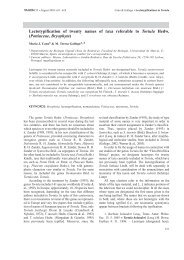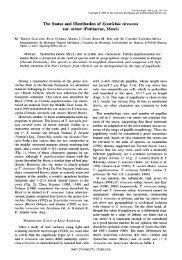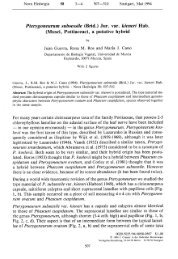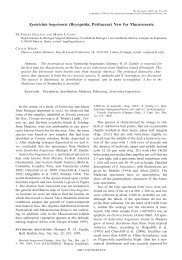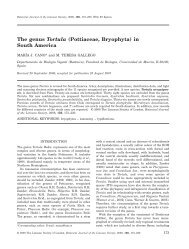Bryological Monograph An annotated checklist of the mosses of ...
Bryological Monograph An annotated checklist of the mosses of ...
Bryological Monograph An annotated checklist of the mosses of ...
Create successful ePaper yourself
Turn your PDF publications into a flip-book with our unique Google optimized e-Paper software.
MOSSES OF EUROPE AND MACARONESIA 241339. Warnstorfia procera is recognized as a species followingHedenäs (1993b).340. The circumscription <strong>of</strong> Leskeaceae and Hypnaceaehas been challenged by Gardiner et al. (2005). Werecognize <strong>the</strong> merit <strong>of</strong> <strong>the</strong>ir proposals, which wouldnecessitate substantial nomenclatural change. Weprefer not to make <strong>the</strong> changes until a more generaloverview <strong>of</strong> families in Hypnales is available.341. Lescuraea secunda is reported from European Russiain <strong>the</strong> Urals (Ignatov & Ignatova, 2004).342. Lindbergia brachyptera, known from <strong>the</strong> RussianCaucasus, was included by Podpěra (1954) butexcluded by Corley et al. (1981) because <strong>the</strong>Caucasus was treated by <strong>the</strong>m as part <strong>of</strong> Asia.343. Pseudoleskea was reinstated as a genus distinct fromLescuraea by Corley & Crundwell (1991), on <strong>the</strong>basis <strong>of</strong> peristome differences emphasized by Crum& <strong>An</strong>derson (1981). The peristome characters nowseem less important, and Ignatov & Ignatova (2004)and Söderström (1998) included Pseudoleskea inLescuraea. A conservative position is adoptedhere, pending more detailed analysis by molecularmethods.344. Pseudoleskea brachyclados (Schwägr.) Kindb., originallydescribed from Austria, is listed for Turkey byKürschner & Erdağ (2005). According to Podpěra(1954) it is a variety <strong>of</strong> P. radicosa (but if so it shouldhave priority at species rank). O<strong>the</strong>r Europeanauthors have treated it as a variety or synonym <strong>of</strong> P.incurvata.345. We follow Wilson & Norris (1989) in includingLeskeella (Limpr.) Loeske 1903 in PseudoleskeellaKindb. 1897.346. Leskeella incrassata type specimen has been examinedby Ignatov; it is very close to Pseudoleskeella nervosaand, if recognized as a species, will prove to becommon in sou<strong>the</strong>rn Europe. For <strong>the</strong> time being <strong>the</strong>two are treated as synonyms.347. Pseudoleskeella rupestris was lectotypified and synonymizedwith P. sibirica by Hedenäs & Söderström(1991).348. In Thuidiaceae, <strong>the</strong> generic concepts <strong>of</strong> Touw (2001a)are adopted here. In particular Pelekium Mitt. (1868)emend. Touw is treated as a synonym <strong>of</strong> Cyrtohypnum(Hampe) Hampe & Lorentz (1869).349. Pelekium atlanticum was described from Madeira asThuidium atlanticum (Hedenäs, 1991). The namePelekium atlanticum (Hedenäs) Touw appears inTouw (2001a), p. 191, but he failed to validate <strong>the</strong>name by a combination, commenting that P. atlanticumis doubtfully distinct from <strong>the</strong> American P.muricatulum (Hampe) Touw. On <strong>the</strong> o<strong>the</strong>r hand,Touw was not prepared to treat P. atlanticum as asynonym <strong>of</strong> P. muricatulum. Hedenäs makes <strong>the</strong>necessary combination above.350. For <strong>the</strong> synonymy <strong>of</strong> Cyrto-hypnum montei withThuidiopsis sparsa, see Touw (2001a, p. 205). Touwnotes that T. sparsa is known only from a former parkarea in Madeira, and suggests that it is an alien,introduced with ornamental plants.351. Thuidium assimile has priority over T. philibertii, basedon <strong>the</strong> large-scale revision <strong>of</strong> Touw (2001b). As notedby Touw, T. assimile belongs to a complex <strong>of</strong> poorlydefined taxa including T. delicatulum. Observations byMrs C.T. van Dorp on European specimens support<strong>the</strong> recognition <strong>of</strong> two weakly distinguished species,ra<strong>the</strong>r than treating T. assimile as a variety <strong>of</strong> T.delicatulum.352. Subfamilial and generic concepts in Brachy<strong>the</strong>ciaceaemostly follow Ignatov & Huttunen (2002).These authors overlooked <strong>the</strong> names HelicodontioideaeM.Fleisch. and Eurhynchioideae Milde, andsuperfluously described <strong>the</strong>se subfamilies asRhynchostegielloideae and Rhynchostegioideae,respectively.353. For <strong>the</strong> taxonomic status <strong>of</strong> Thamnium cossyrenseBott. var. cossyrense and var. melitense Bott. seeMastracci (2001).354. Platyhypnidium grolleanum was described from CzechRepublic by Ochyra & Bednarek-Ochyra (1999).355. Platyhypnidium mutatum was described by Ochyra &Vanderpoorten (1999); molecular studies did not finddifferences between this species and P. riparioides(Stech & Frahm, 1999). Frahm (2005a) asserts that itis a somatic mutant <strong>of</strong> P. riparioides.356. Platyhypnidium torrenticola was described asGradsteinia torrenticola from <strong>the</strong> Canary Islands byOchyra, Schmidt & Bultmann (1998) and subsequentlytransferred to <strong>the</strong> genus Platyhypnidium.357. The status <strong>of</strong> Rhynchostegium arcticum was reevaluatedby Ignatov & Huttunen (2002).358. Rhynchostegium surrectum was synonymized with R.confertum by Hedenäs (1992b).359. Brachy<strong>the</strong>cium cardotii was synonymized withRhynchostegium megapolitanum by Hedenäs (1992b).360. Barbella strongylensis was transferred to Rhynchostegiumby Buck & Privitera (1999).361. Clasmatodon parvulus (Hampe) Sull. is excluded.Heras, Infante & Buck (2006) have found that everySpanish specimen named as Clasmatodon wasPseudoleskeella tectorum. <strong>An</strong> old German record from1851 is poorly localized (Müller, 2004) and is unlikelyto be C. parvulus.362. Nobregaea latinervis is a morphologically very peculiarspecies known from a single locality in Madeira; it wasdescribed by Hedenäs (1992b).363. Synonymy <strong>of</strong> Helicodontium capillare follows CortiniPedrotti (2006 [2005]), who indicates that a specimen<strong>of</strong> <strong>the</strong> supposedly endemic H. italicum had beenidentified as H. capillare by W.R. Buck.364. Rhynchostegiella bourgaeana is treated by Dirkse &Bouman (1995a) as an endemic <strong>of</strong> <strong>the</strong> Canary Islands.On <strong>the</strong> o<strong>the</strong>r hand, Corley et al. (1991) and Hedenäs(1992b) regarded it as a synonym <strong>of</strong> R. tenella.




